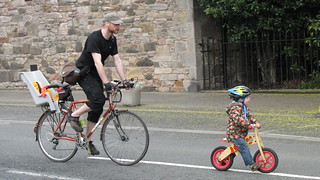We had an American friend of mine from Seattle round for Christmas dinner, and driving him round to our place (before anyone jumps up and down, he suffers from CRPS so cycling (even an upright trike or the like given the pain is in his ankle) is not even remotely an option) we got to talking about traffic laws.
He pointed out some cars parked on the road facing the wrong way for the lane they were in. Apparently in Seattle such cars would have been ticketed because, and this blew my mind as a piece of logical reasoning, the car must have been driven the wrong way on the carriageway in order to get there. I then pointed out that in the UK a car parked on the pavement can't be given a ticket unless the polis see it actually driving there and he was utterly incredulous. The simple, obvious question (that we've all posed) being "Well how do they think the car got there? Did it just teleport?"

 posts
posts
